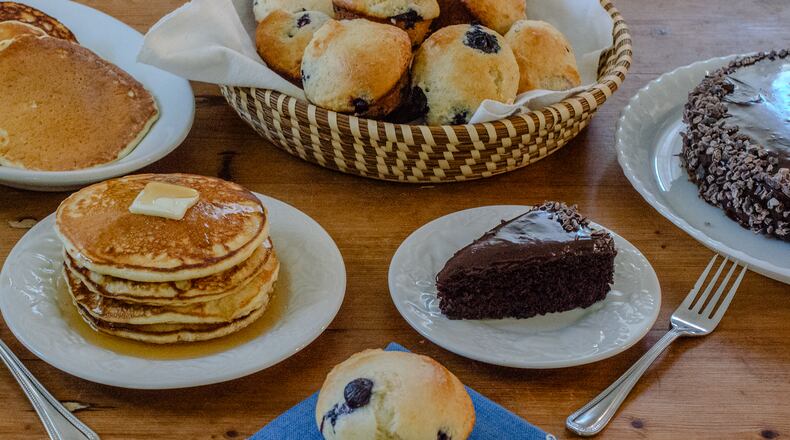Egg prices have been in the news for months. Prices peaked in February, with some restaurants including Waffle House and Denny’s adding an egg surcharge. While it is straightforward to opt out of scrambled eggs at home or an omelet at brunch, baking often requires eggs. Eggless baking can be achieved through chemistry, aided by a dual combination of old-timey frugality and newfangled plant-based cooking.
Eggs provide structure, leavening, moisture and flavor in baked goods. The whites function as a binder and leavening agent. The yolks add fat and perform as an emulsifier, a substance that combines liquids that do not naturally mix. To replace eggs in baking, ingredients have to mimic eggs’ key functions.
Baking powder and baking soda have been part of the baking pantry for more than 100 years. They are chemical leavening agents that react with an acid to create bubbles and give baked goods, both with and without eggs, their rise.
Two plant-based egg substitutes are newer to the baker’s kitchen. Ground flax forms a gel-like substance when combined with liquid, acting as an emulsifier and binder. Aquafaba, which translates as “bean water,” is the cooking liquid found in a can of beans, most often chickpeas. It contains proteins and starches that allow it to act as both an emulsifier and binder.
Even when egg prices drop, these simple and satisfying recipes are guaranteed to be valuable additions to your baking repertoire.
RECIPES
This trio of eggless recipes covers basic baking needs: a good old-fashioned chocolate cake, buttery pancakes and fruity muffins. Wacky Cake, Flaxseed Pancakes and Aquafaba Blueberry Lemon Muffins make eggless baking easy and economical.
Credit: Virginia Willis for The Atlanta Journal-Constitution
Credit: Virginia Willis for The Atlanta Journal-Constitution
Wacky Cake
Also known as crazy cake or Depression cake, this cake originated during the Great Depression. Containing baking powder, baking soda, cocoa and vinegar, this is a glorified science experiment. The cake alone is rich, dark and delicious. Pour the chocolate ganache glaze over it for a luxurious showstopper.
- 6 tablespoons Special Dark Dutch-process cocoa powder, divided
- 1 1/2 cups all-purpose flour
- 1 cup sugar
- 1 teaspoon baking soda
- ¾ teaspoon baking powder
- 1/2 teaspoon fine sea salt
- 1 cup warm water
- 6 tablespoons light olive oil
- 1 tablespoon apple cider vinegar
- 1 teaspoon pure vanilla extract
- 12 ounces semisweet dark chocolate chips
- 1 ¼ cups heavy cream or vegan unsweetened creamer
- ¼ cup cacao nibs, for garnish (optional)
- Position a rack in the middle of the oven. Heat the oven to 350 degrees. Spray a 9-by-2-inch cake pan with nonstick cooking spray. Sift 2 tablespoons of the cocoa powder over the prepared pan, tilting to cover the bottom and sides. Set aside.
- In a medium bowl, whisk together the remaining 4 tablespoons cocoa, flour, sugar, baking soda, baking powder and salt. In a separate bowl or large liquid measuring cup, combine the water, oil, vinegar and vanilla. Add the wet ingredients to the dry and whisk until the batter is smooth. Pour the batter into the prepared pan.
- Transfer to the oven and bake until the sides of the cake begin to pull away from the pan and a toothpick inserted in the center comes out with a few crumbs, about 25 minutes. Cool in the pan on a wire rack for 10 minutes.
- Invert the cake onto the wire rack, bottom side up. Place the rack over a rimmed baking sheet. (This creates the proper setup to glaze the cake.) Let cool completely while you prepare the ganache.
- Make the ganache: Place the chocolate chips in a medium bowl. Heat the cream in a small saucepan over medium heat until small bubbles form around the edge of the saucepan, about 3 minutes. Pour the hot cream over the chocolate. Let the mixture rest without stirring for 2 minutes. Stir gently with a rubber spatula until completely smooth. (If it is not smooth, microwave it in 15-second increments, stirring after each interval, until smooth and all the chocolate is melted.)
- Fill a large bowl with ice. Add just enough water to reach the top of the ice without submerging the ice. Place the chocolate ganache bowl on top of the ice. (It’s important the water not splash into the ganache.) Stir with the rubber spatula until the chocolate ganache is slightly chilled and about the consistency of pancake batter.
- Slowly pour the ganache over the top of the cooled cake, starting at the center. (It should pour and settle on the cake, not soak into the cake or run off in sheets.) Once the ganache covers the top, using a ladle or metal spoon, drizzle the ganache around the edges of the cake top to trickle down and coat the sides. Place the baking sheet, cooling rack and cake into the refrigerator to set, about 15 minutes.
- Remove the cake from the refrigerator. Using a large offset spatula, remove the cake from the rack and transfer it to a serving plate. (If the pooled ganache is clean and free of crumbs, it can be scooped up with a rubber spatula and reused.) If desired, sprinkle the cacao nibs around the top edge and sides of the cake, pressing them into the ganache. Cover with a cake dome or a large inverted bowl that will not touch the cake, if possible and refrigerate until ready to serve. Store up to 3 days in the refrigerator.
Serves 16.
Per serving: 307 calories (percent of calories from fat, 51), 3 grams protein, 37 grams carbohydrates, 25 grams total sugars, 2 grams fiber, 19 grams total fat (9 grams saturated), 21 milligrams cholesterol, 176 milligrams sodium.
Credit: Virginia Willis for The Atlanta Journal-Constitution
Credit: Virginia Willis for The Atlanta Journal-Constitution
Flaxseed Pancakes
You will never know these golden brown and fluffy pancakes are eggless. Many recipes call for a flax egg, a combination of ground flax and water. In this recipe, the flax is added to the dry ingredients and the milk activates the flaxseed gel without diluting the flavor.
Use plant-based butter and milk for vegan pancakes.
- 2 cups all-purpose flour
- 2 tablespoons sugar
- 1 tablespoon baking powder
- 1 teaspoon ground flaxseeds
- ¾ teaspoon fine sea salt
- ½ teaspoon baking soda
- 2 cups 1% milk or oat milk, room temperature
- 3 tablespoons unsalted butter or vegan butter, melted, plus more for cooking the pancakes
- 2 tablespoons lemon juice
- ½ teaspoon pure vanilla extract
- Maple syrup, for serving
- Place a rimmed baking sheet in the oven. Heat the oven to 300 degrees.
- Whisk flour, sugar, baking powder, ground flaxseeds, salt and baking soda together in a large bowl. In a second bowl or large liquid measuring cup, whisk to combine the milk, melted butter, lemon juice and vanilla extract. Add the milk mixture to the dry ingredients and gently whisk until just incorporated.
- Place a large nonstick skillet over medium heat. Add a small pat of butter and melt until foaming. Swirl around the pan to coat. Using a 2-ounce ladle or ¼-cup measuring cup, add batter into the pan for each pancake, cooking only a few at a time. Cook until the bubbles on the top burst and the bottoms are golden brown, about 1 ½ minutes. Flip the pancakes and cook until golden, about 1 minute more. Transfer to the baking sheet in the oven to keep warm. Repeat with the remaining batter, adding more butter to the pan as necessary. Serve hot or warm with maple syrup.
Makes 12 pancakes.
Per pancake: 136 calories (percent of calories from fat, 26), 4 grams protein, 21 grams carbohydrates, 4 grams total sugars, 1 gram fiber, 4 grams total fat (2 grams saturated), 10 milligrams cholesterol, 307 milligrams sodium.
Credit: Virginia Willis for The Atlanta Journal-Constitution
Credit: Virginia Willis for The Atlanta Journal-Constitution
Aquafaba Blueberry Lemon Muffins
Aquafaba, the liquid in a can of chickpeas, is a reliable substitute for egg whites. To use, simply drain one can of chickpeas, reserving the chickpeas for another use. Most chickpeas cans contain between 1/2 cup and 3/4 cup of aquafaba. Freeze excess aquafaba in small containers such as ice cube trays for later use.
- 2 ⅔ cups all-purpose flour
- 1 cup sugar
- 1 tablespoon baking powder
- ¾ teaspoon fine sea salt
- ½ teaspoon baking soda
- 1 cup blueberries
- 1 cup plain low-fat yogurt
- ½ cup 1% milk
- 7 tablespoons light olive oil
- Zest and juice of 1 lemon
- ¼ teaspoon pure lemon extract
- 3 tablespoons aquafaba
- ½ teaspoon cream of tartar
- Adjust an oven rack to the upper-middle position and heat oven to 425 degrees. Spray a 12-cup muffin tin with nonstick spray.
- In a large bowl, whisk together the flour, sugar, baking powder, salt and baking soda. Add blueberries and gently toss to combine and coat. In a second bowl or large liquid measuring cup, whisk the yogurt, milk, oil, lemon zest, lemon juice and lemon extract; set aside.
- Place the aquafaba in a medium bowl. Add the cream of tartar. Using a handheld mixer, whip on high speed until stiff peaks form, 3 to 5 minutes.
- Using a rubber spatula, fold the yogurt mixture into the dry ingredients. The batter will be thick. Whisk one-third of the whipped aquafaba into the batter to loosen the batter. Add the remaining whipped aquafaba and gently fold into the batter with a rubber spatula until no white streaks remain.
- Using a large spring-loaded ice cream scoop or a large spoon, divide the batter evenly among prepared muffin cups. Bake until golden brown and the muffins start to pull from the sides of the pan, about 20 minutes, rotating the muffin tin front-to-back halfway through baking.
- Remove to a rack to cool in the tins for 20 minutes, then transfer the muffins to the wire rack and let cool for an additional 5 to 7 minutes. Serve warm or at room temperature. Store in an airtight container at room temperature for up to 3 days.
Makes 12.
Per muffin: 262 calories (percent of calories from fat, 29), 4 grams protein, 42 grams carbohydrates, 20 grams total sugars, 1 gram fiber, 9 grams total fat (1 gram saturated), 2 milligrams cholesterol, 308 milligrams sodium.
Sign up for the AJC Food and Dining Newsletter
Read more stories like this by liking Atlanta Restaurant Scene on Facebook, following @ATLDiningNews on X and @ajcdining on Instagram.
About the Author
Keep Reading
The Latest
Featured






